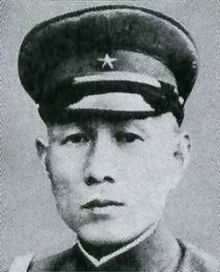Hayao Tada
| Hayao Tada | |
|---|---|
 General Hayao Tada | |
| Born |
February 24, 1882 Sendai, Miyagi, Japan |
| Died | December 16, 1948 (aged 66) |
| Allegiance |
|
| Service/branch |
|
| Years of service | 1903 -1945 |
| Rank | General |
| Commands held | IJA 11th Division, IJA Third Army, North China Area Army |
| Battles/wars |
Russo-Japanese War Second Sino-Japanese War |
| Awards | Order of the Golden Kite (2nd class) |
Hayao Tada (多田 駿 Tada Hayao, 24 February 1882 – 16 December 1948) was a general in the Imperial Japanese Army in the Second Sino-Japanese War.
Biography
A native of Sendai, Miyagi prefecture, Tada graduated from the 15th class of the Imperial Japanese Army Academy in 1903. He served in the artillery during the Russo-Japanese War.
Tada graduated from the 25th class of the Army War College (Japan) in 1913. He served as an instructor to the Chinese Army at the Beijing Military Academy from 1926-1927. After returning to Japan, he served as an instructor at the Army War College from 1927–1928, before being give a field command as commander of the IJA 4th Field Artillery Regiment in 1928. He was promoted to Chief of staff (military) of the IJA 16th Division in 1930.[1]
Tada returned to the Beijing Military Academy from 1931-1932. From 1932-1934, Tada was Chief Military Advisor to the Empire of Manchukuo. For a time he had as a mistress Princess Aisin Gioro Xianyu (AKA "Eastern Jewel" who by then had taken a Japanese name of Yoshiko Kawashima), a member of the Qing Royal Family who helped persuade Pu Yi to become the emperor of Manchukuo. From 1 August 1935 – 1 May 1936 Tada served as commander in chief of the China Garrison Army.
Shortly before the outbreak of the Second Sino-Japanese War, Tada assumed command of the IJA 11th Division. However, he was recalled to Japan on 14 August 1937 to become Vice Chief of the Imperial Japanese Army General Staff. He concurrently held the post of Commandant of the Army Staff College.
After the Marco Polo Bridge Incident, Tada attempted to contact Kuomintang leader Chiang Kai-shek to defuse tensions between Japan and China. Tada argued that both countries faced the same external threat from the Soviet Union and internal threat from communism, and should not waste precious resources fighting one another; however, Tada's efforts were overruled by Prime Minister Fumimaro Konoe, Army Minister Hajime Sugiyama, Navy Minister Mitsumasa Yonai and Foreign Minister Koki Hirota, all of whom berated Tada for attempting to effect private diplomacy.
Tada returned to China on 10 December 1938 as commander of the Japanese Third Army. On 12 September 1939, he was promoted to commander in chief of the North China Area Army. Despite his earlier efforts at peace, Tada was a vigorous commander, and promoted the separation of the northern provinces of China into a puppet state independent of control of the Kuomintang government.
Tada was awarded the Order of the Golden Kite, 2nd class in July 1941, and was promoted to full general. He retired from active military service two months later.
After the end of the war, Tada was arrested by the SCAP occupation authorities and was held for trial for alleged “Class A” war crimes. He died in prison on 16 December 1948, before the end of the trial. It was revealed a week after his death that he was scheduled to have been released without charges being pressed.
References
Books
- Dorn, Frank (1974). The Sino-Japanese War, 1937-41;: From Marco Polo Bridge to Pearl Harbor. MacMillan. isbn = 0-02-532200-1.
External links
- Ammenthorp, Steen. "Tada Hayao". The Generals of World War II.
- Japanese bio site
Notes
- ↑ Ammenthorp, The Generals of World War II